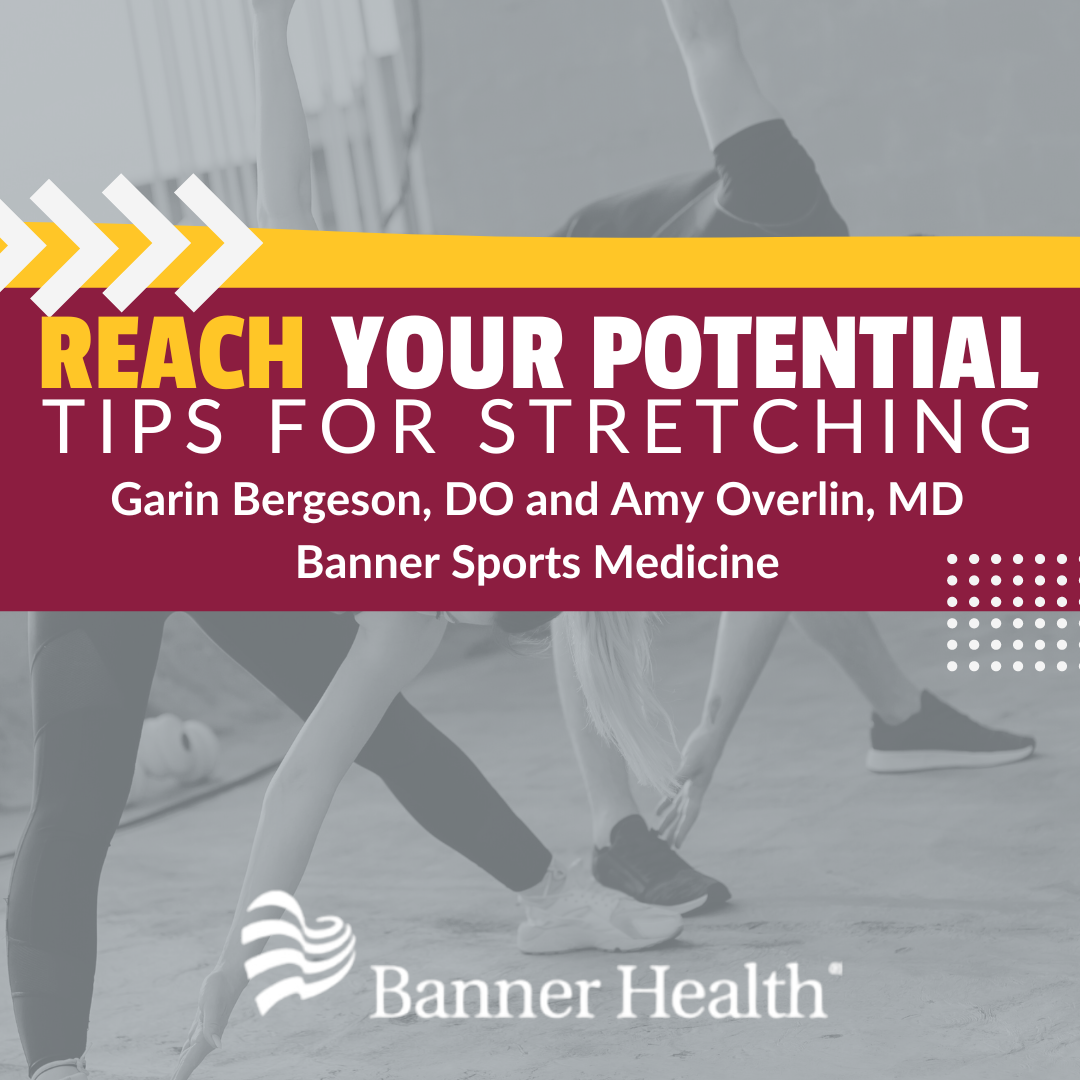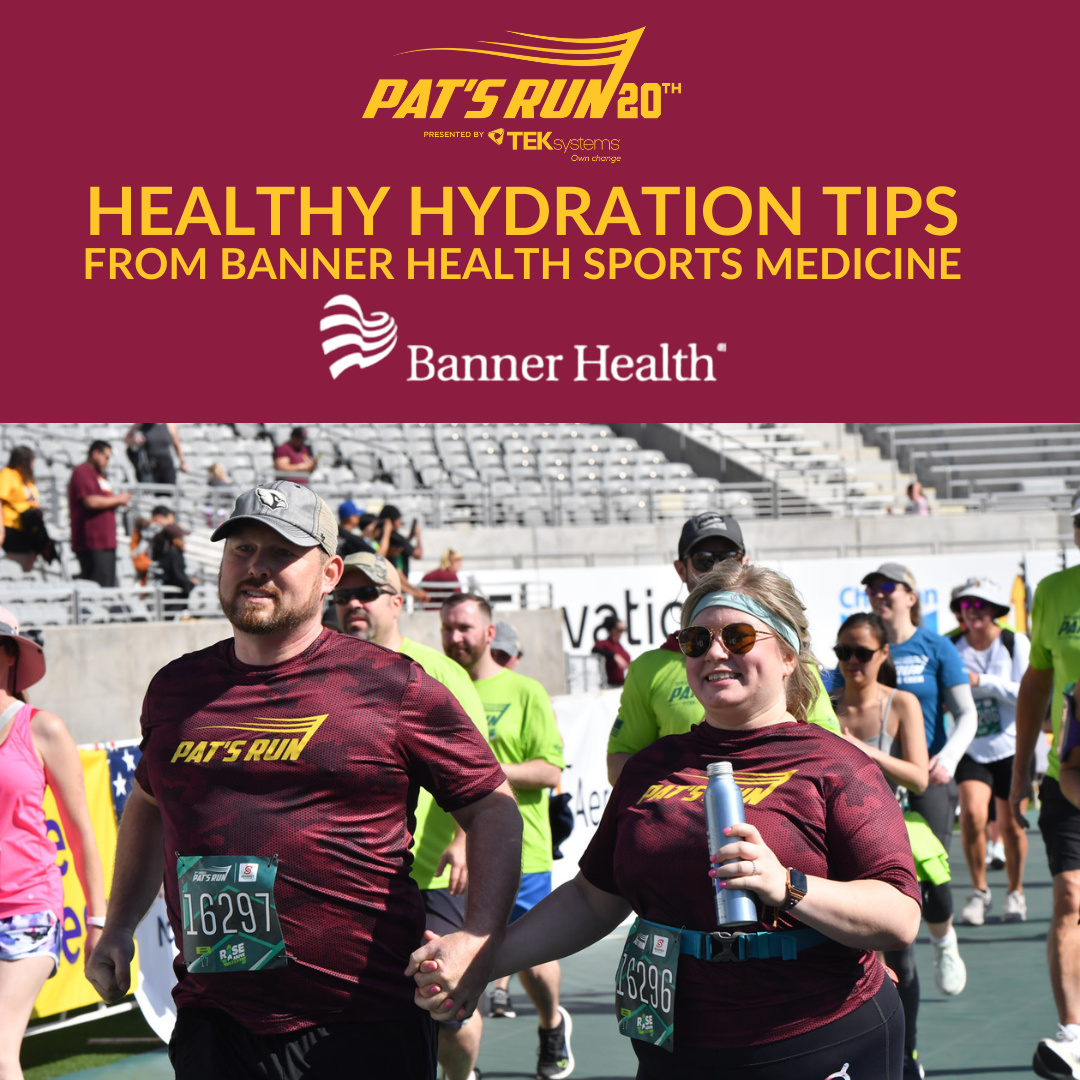Reach Your Potential: Stretching Tips from Banner Health Sports Medicine
Walking, jogging, or running are all fantastic forms of exercise for getting your body moving, your heart pumping, and your muscles working. As important as staying active is, it is just as important to protect your muscles and joints by maintaining your flexibility. Check out these tips from Garin Bergeson, DO and Amy Overlin, MD from Banner Health Sports Medicine Team below.
Flexibility is defined as the range of motion of a joint or group of joints that results in pain-free arc of motion.
- Stretching keeps muscles flexible allowing full-range of motion of a joint
- Increased range of motion allows increased forces to be generated or absorbed
- Resulting in both increased strength and function and decreased injury risk
Now let’s focus on how. There are different approaches to stretching depending on when during a workout you will be performing the stretches.
BEFORE WORKOUTS: Light stretching or dynamic stretching serves as a great warm-up to exercise by getting blood flowing to your muscles.
AFTER WORKOUTS: Long stretches and static holds serve as an ideal cooldown that improves flexibility over time.
General Stretching Tips:
#1: DON’T OVERDO IT!
- Stretching should NOT be painful.
- Stretch to a slight discomfort, not pain.
- Pain is your body’s way of telling you to stop so do not push through it.
#2: STRETCHING CAN SERVE AS A WARM-UP!
- Pre-workout stretching involves dynamic stretches.
- Dynamic stretching is combining motions that stretch and work muscles without straining them while they’re ‘cold’.
- Studies have shown static stretching before a workout can actually increase the risk of injury, while dynamic stretching improves blood flow and lets your muscles know they’re about to work.
#3: STRETCHING CAN BE YOUR COOL DOWN!
Stretching after a workout while your muscles are ‘warm’ and have plenty of blood flowing is your best window of opportunity to improve flexibility.
- When your muscles are warm and your exercise routine is behind you, this is the time for long 30-45-second holds to improve overall flexibility.
- DO NOT ‘bounce’ while stretching as this can increase the risk of injury.
- Constant tension of the muscle is the key to making your muscles more pliable.
#4: CONSISTENCY IS KEY!
With consistent stretching, your flexibility can begin to improve as quickly as a couple of weeks.
Now, Let’s Practice!
There are hundreds of muscles in the body so it can be pretty overwhelming as to where to start. For a runner, jogger, or walker, the answer is at least a little easier. The most important muscles to stretch are going to focus on the lower body. Below are some simple stretches that should be done AFTER your workout to improve your flexibility.
QUADRICEPS
 Often referred to as the quads, these muscles cover the front and sides of your thighs. These muscles provide stability to the knee and power you up hills and through your run.
Often referred to as the quads, these muscles cover the front and sides of your thighs. These muscles provide stability to the knee and power you up hills and through your run.
Instructions:
Stand upright and pull your one leg behind you with the same side hand. Tighten your butt muscles and pull your heel toward your rear. Keep your knee pointing downward as you do this stretch and try not to arch your back. After holding for 30 seconds, switch to the other leg. You can also use a chair to balance yourself. You should feel the tension in the front of your thigh, and from your front hip down to the knee.
HAMSTRINGS
 These muscles cover the back of your thigh, stretching from the hip to the lower leg.
These muscles cover the back of your thigh, stretching from the hip to the lower leg.
Instructions:
Sit OR stand on the ground and extend one leg forward. If sitting, bend the opposite knee until the foot is flat against your inner thigh. Lean forward, bending your hips without rounding your back and waist toward the outstretched foot as if reaching for your toes. Hold for at least 30-45 seconds and repeat on your other leg.
Be careful not to pull back your toe during this stretch. You should feel it in the back of your thigh, from your knees to your bottom.
CALVES
 The muscles of your lower legs are a critical spot to pay attention. Poor calf stretching can lead to very uncomfortable muscle tightness and pain. There are actually two muscles in your calf called the gastrocnemius and your soleus.
The muscles of your lower legs are a critical spot to pay attention. Poor calf stretching can lead to very uncomfortable muscle tightness and pain. There are actually two muscles in your calf called the gastrocnemius and your soleus.
Instructions:
Stand with your one foot forward and one foot backward in a staggered or lunge position. Bend your front knee forward while keeping your back leg straight to stretch the gastrocnemius. Keep the heel of your back foot planted on the ground, toes pointing straight. Keep your back straight and hold the pose for at least 30 seconds. Repeat with your other leg.
To stretch the soleus, repeat the above with step 2 including bending both your front and BACK knee, while maintaining the upright lunge position, until you feel a stretch in the back of your lower leg.
HIP FLEXORS
 The Psoas (pronounced “so-az”) muscle is on the front of your spine and hip that connects the lower back to the upper thigh. This connection is what allows us to flex and bring the thigh upwards resulting in an elevated knee. (Think “high knees” during running drills.)
The Psoas (pronounced “so-az”) muscle is on the front of your spine and hip that connects the lower back to the upper thigh. This connection is what allows us to flex and bring the thigh upwards resulting in an elevated knee. (Think “high knees” during running drills.)
Instructions:
Start by placing one foot forward and one foot backward as if you are going into your calf stretch but instead of standing, kneel down on your back knee. Use padding under your knee if you have any knee issues. Keep your chest and shoulders upright and tuck your pelvis under your hips (maintaining a straight line from head to tailbone) while you tighten your buttocks. Now gently push your hips forward towards the front leg, until you feel a stretch in the front of your hip and hold for at least 30 seconds. Be careful NOT to arch the lower back. This will not isolate the iliopsoas. Repeat on the other side.
PIRIFORMIS / GLUTES
The body’s posterior hip muscles make up the buttocks and plays a vital role in running. These muscles work to control your hips and thighs while running, creating power to power your run.
Instructions:

Lie on your back with knees bent at 90 degrees with feet flat on the floor. Cross your one ankle over the opposite knee. Grab behind your thigh (this is the leg that has your ankle resting on your knee), interlace your fingers, and pull your leg towards your chest. You should feel the stretch in your butt and hold for at least 30 seconds, then switch sides.
Alternative:
Lie on your back to perform this stretch. To stretch the piriformis/posterior hip, grasp your bent right knee with your right hand and your right ankle with your left hand (both overhand grips). Pull the right knee and ankle at an angle in unison toward your left shoulder. You should feel the stretch in your posterior hip/glutes and hold for at least 30 seconds, then switch sides.
There are many variations of the stretches we have reviewed. If one doesn’t work for you, there is always an alternative out there. The key again is to maintain the stretches for at least 30 seconds to overcome our stubborn nerve response and increase our flexibility. Also, be patient, change takes time and repetition but with persistence and consistency, you will see the results!





